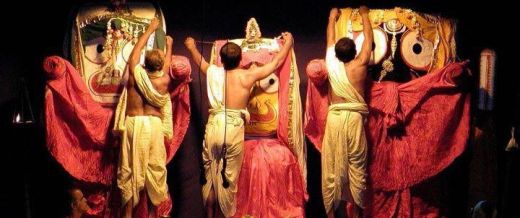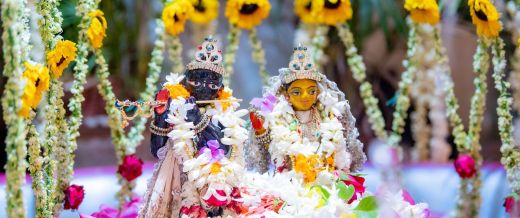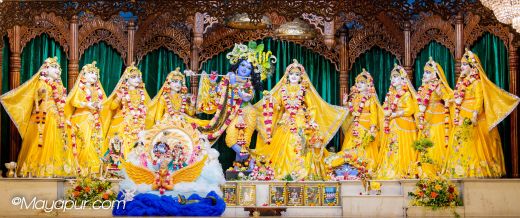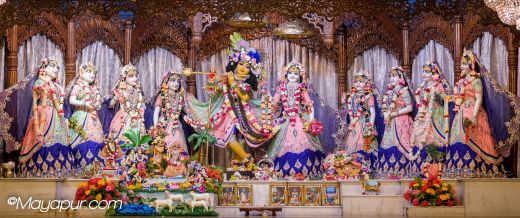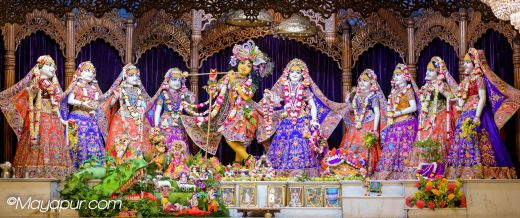Why is Lord Jagannath Dressed in Elephant Costumes on Snana Yatra?
Once upon a time, a renowned and devout worshipper of Lord Ganesha made a visit to Puri. This devotee was known for his unwavering devotion—he worshipped no one but Sri Ganesha and considered Him the Supreme.
When he arrived in Puri, the king warmly welcomed him and invited him to have darshan of Lord Jagannath in the grand temple. However, the devotee politely declined.
He explained, "My heart belongs solely to Lord Ganesha. I do not visit any other deity’s temple."
The king, being a great devotee of Lord Jagannath and also well-versed in the scriptures, gently reasoned with him, saying, “But dear sir, Lord Jagannath is none other than Lord Vishnu Himself—He is the source of all the demigods, including your beloved Ganesha.”
Still hesitant, the devotee eventually agreed, out of respect for the king, to accompany him to the temple—though his mind remained fixed on Lord Ganesha.
It happened to be the sacred day of Snana Yatra, the grand public bathing ceremony of Lord Jagannath, Baladeva, and Subhadra Devi. The atmosphere was festive and divine. As the devotee stood before the altar and beheld the enormous deities adorned with flower garlands and sandalwood paste, he folded his hands and prayed silently:
“O Lord, if You truly are the Supreme, and if all demigods indeed reside within You, then please reveal to me the form of my Lord Ganesha.”
Just then, something miraculous happened.
Before the eyes of all present—and especially the astonished devotee—Lord Jagannath manifested Himself in a form with a large head and trunk, resembling Lord Ganesha! The devotee was overwhelmed with emotion. Tears flowed from his eyes. His heart overflowed with love, awe, and reverence. He realized in that moment the deeper truth: that the Supreme Lord takes on various forms to reciprocate with the love of His devotees.
This merciful pastime came to be remembered eternally, and since then, on the day of Snana Yatra, Lord Jagannath is decorated in an elephant-like costume, known as Gaja Vesha, to commemorate this beautiful exchange of love.
This pastime is lovingly recounted in H.G. Pankajanghri Prabhu’s book: “The Pastimes & History of Lord Jagannath in Rajapur.”
Offer a Seva this Snana Yatra, Just 6 Days to Go!!! https://www.mayapur.com/festivals/Snana-Yatra
Biodiversity in Bhakti Yoga: A Devotional Offering
ISKCON Mayapur joyfully presents “Biodiversity in Bhakti Yoga”—a heartfelt visual and meditative offering designed to reconnect hearts with the sacred natural world of Sri Mayapur Dhama. Featuring over 500 breathtaking images of local flora and fauna, accompanied by spiritual insights from Srila Prabhupada’s teachings, this offering invites viewers to see nature through the lens of Krishna consciousness. As part of the ‘CONNECT with Sri Mayapur-dhama’ project, it encourages us to perceive and remember the Lord in every aspect of creation—promoting mindful devotion, compassionate living, and a deep spiritual bond with Mother Earth as an expression of our bhakti.
To explore the mobile-friendly digital gateway, click here. https://srimayapurdhama.com/biodiversity/
Srila Prabhupada said, “Simply by remembering this picture, that is perfection. Because we need to become Kṛṣṇa conscious. We should constantly think of Kṛṣṇa. If you think of Him in any way, that is your perfection.” (Lecture – December 1, 1968, Los Angeles). This profound instruction forms the foundation of the ‘Biodiversity in Bhakti Yoga’ initiative. It invites devotees to see nature as Krishna’s sacred footprint—guiding our hearts deeper into remembrance, gratitude, and loving service to the Lord.
Inspiring Meditation Through Nature
Each image—whether a blooming lotus, the fleeting flight of a bird, or sunlight dancing through the trees—becomes a gateway to meditation. These moments in nature remind us that Krishna is the original artist, and that the creation itself is one of His divine expressions. Just as devotees meditate on Krishna’s form, we can also learn to respect and honor the beauty around us, recognizing it as sacred.
Kṛṣṇa’s Divine Form in Nature’s Elements
Nature, in all its splendor, reflects the spiritual qualities of Krishna’s own transcendental body https://srimayapurdhama.com/biodiversity/nature-krishna/. “What they call beautiful nature is but His smile…What they call the sweet songs of the birds are but specimens of the whispering voice of the Lord.” (SB 1.11.26 Purport) Srila Prabhupada also writes, “The bereavement of material existence immediately subsides when one sees the charming smile of the Lord.” (SB 3.28.32, Purport) Even a few mindful moments in nature can ease the burdens of the heart and awaken deep spiritual joy—reminding us of Krishna’s smile, which is sweeter than the sweetness itself.
Revealing Nature’s Role in Krishna’s Pastimes
Vedic scriptures beautifully portray how forests, rivers, animals, and hills become active participants in the Lord’s transcendental pastimes. Whether it is Krishna’s worship of Govardhan Hill or Lord Sri Caitanya Mahaprabhu’s ecstatic travels through the forests of Jhārikhaṇḍa, nature serves as a sacred stage for divine lila. This project encourages devotees to rediscover these spiritual connections and to recognize biodiversity and harmonious living as integral expressions of Vedic culture and Krishna consciousness.
Promoting Ahimsa and Compassion for All Living Beings
In Bhagavad-gītā 15.7, Lord Krishna declares: “The living entities in this conditioned world are My eternal fragmental parts.” This vision of spiritual unity lies at the heart of the Biodiversity in Bhakti Yoga project—encouraging the practice of ahimsa (non-violence) and deeper compassion, not only toward fellow humans but also toward plants, birds, insects, and animals.
Bhakti Begins at Home: A Devotional Call to Honor Mother Earth
Krishna assures us, “If one offers Me with love and devotion a leaf, a flower, a fruit, or water, I will accept it.” (BG 9.26) Inspired by these words, we invite devotees worldwide to express their bhakti through care, respect, and a lifestyle harmonious with Mother Earth. Plant a tree, grow flowers for your Deities, walk through a forest while chanting the holy names, pause to appreciate a bird’s song or the breeze through the trees. These simple, mindful acts become beautiful offerings of love and devotion to Krishna—honoring His creation while strengthening our connection with Him
Caring for Mother Earth is an expression of our bhakti. Every tree, every flower, every gentle breeze is a reminder of Krishna’s loving presence. When we engage with nature in a spirit of devotion, we not only help protect the environment — we also deepen our relationship with Him.
A Prayer for Sacred Connection
As described in The Nectar of Devotion: “Every part of Kṛṣṇa’s body was so soft that even at the touch of newly grown leaves, the color of the touched part of His skin would change.” (NOD 26) Let us pray that every time we touch a new leaf, we remember Krishna and feel inspired to serve Him by caring for His sacred creation. May this awareness keep us grounded in loving devotion and forever sheltered at the lotus feet of Lord Sri Caitanya Mahaprabhu and His eternal abode — Sri Mayapur Dhama.
https://online.flippingbook.com/view/555338030/
Support this Initiative
We warmly invite you to share your feedback and suggestions to help us enhance the “CONNECT with Sri Mayapur-dhama” project by clicking here https://srimayapurdhama.com/follow-us/. We are grateful for your support in spreading this initiative among your friends, family, and congregation, creating a valuable opportunity for devotees worldwide to experience the mercy of Sri Mayapur-dhama. Your generosity and encouragement are essential to the success and growth of this project. If you feel inspired to contribute, please click the donate link here https://srimayapurdhama.com/donate-now/.
CONNECT with Sri Mayapur-dhama – Mobile App, YouTube / Facebook / WhatsApp group / Testimonials.
Mobile App - https://srimayapurdhama.com/app/
YouTube - https://www.youtube.com/@srimayapurdhama
Facebook - https://www.facebook.com/srimayapurdhama
WhatsApp Group - https://chat.whatsapp.com/CEycpWMJibyA636bxxb9kk
Testimonials - https://srimayapurdhama.com/testimonials/
By Nandan Dasa, Mayapur Master Plan Office
Sri Jagannath Snana Yatra June 11th!
After the beautiful Chandan Yatra festival, the devotees start preparing for a very important day—Snana Yatra, the Lord’s bathing ceremony. Around 21 days after Chandan Yatra is one of the most heartfelt festivals here.
On this day, devotees from all around come with great enthusiasm. They bring items like milk, yogurt, sugar candy, green coconut water, honey, turmeric water, flower garlands, and more. Everyone offers whatever they can, and it becomes a big, joyful service.
The Abhisheka, or bathing of the Lord, goes on for hours—sometimes from the morning until late evening. In the later part of the day, there are usually some cultural presentations and kirtans offered for the pleasure of Their Lordships, followed by prasadam distribution for everyone. The whole atmosphere feels like a big family gathering, with everyone coming together just to serve and please Lord Jagannatha.
But something interesting happens after this long bath.
The next day, the Lord falls sick.
Because He has received so many loving offerings and stayed in the open air for so long, it is said that He catches a cold. The Lord then rests and doesn’t give darshan for several days. This time is known as Anavasara—a period when He is cared for by His devotees and given herbal treatments and simple foods to help Him recover.
There’s a sweet pastime behind this.
The origins of the Snana Yatra are deeply rooted in the Skanda Purana, which narrates the story of King Indradyumna, who installed the wooden deities and initiated this sacred bathing festival. This festival commemorates the appearance of Lord Jagannath – the Lord of the Universe. It is said that when King Indradyumna arranged the bathing ceremony for the deities, he set a precedent for the celebration of Snana Yatra, making it an integral part of the Jagannath worship tradition.
The festival serves multiple purposes, including spiritual cleansing, where devotees believe that witnessing the deities during Snana Yatra absolves them of all sins, making the sight of the Lord being bathed highly auspicious and purifying.
During Anavasara, devotees feel the pain of separation. The temple feels quiet, and everyone waits eagerly to see the Lord again. It is in this waiting that our love for Him grows even deeper.
This simple festival reminds us how personal our relationship with Krishna is. He accepts our little offerings, our songs, our service—and sometimes, He even lets us take care of Him.
What a merciful Lord.
For Seva to Lord Jagannatha: https://www.mayapur.com/festivals/Snana-Yatra
Chipped Rice Festival June 9th, 2025
Every year, the Vaishnava community around the world joyfully celebrates Panihati Chida-Dahi Mahotsav, the Festival of Chipped Rice and Yogurt, commemorating one of the most heartwarming pastimes of Lord Nityananda Prabhu and Srila Raghunatha Dasa Goswami. This transcendental event, rich in devotional spirit and divine reciprocation, took place on the banks of the sacred Ganges River in Panihati, a village just north of modern-day Kolkata (West Bengal, India).
The Origin of the Festival
The festival traces its origin to a beautiful pastime narrated in Sri Caitanya-caritamrta, wherein Raghunatha Dasa, eager to receive the mercy of Lord Nityananda, approached Him in Panihati. At that time, Lord Nityananda was seated beneath a tree on the Ganges’ bank, surrounded by His associates and kirtana performers. Upon seeing Raghunatha Dasa, the Lord affectionately called him a “thief” for trying to hide, and—placing His lotus feet on Raghunatha's head—ordered him to organize a grand feast of chipped rice and yogurt for all the devotees present.
Raghunatha Dasa joyfully accepted the order and immediately set out to arrange an opulent festival. He brought large quantities of chipped rice (chida), yogurt (dahi), milk, sugar, bananas, and other delightful ingredients. With heartfelt devotion, he prepared two varieties of dishes—chipped rice soaked in yogurt and bananas, and chipped rice soaked in condensed milk with sweet fruits and camphor. Earthen pots were filled and distributed among the assembled devotees.
A Feast for Thousands
As news of the festival spread, thousands of brahmanas, scholars, and villagers flocked to the site, eager to participate. With no space left on land, some even waded into the Ganges with their pots to relish the prasadam. The scene was extraordinary—devotees chanting "Hari Hari", laughing joyfully, and relishing the Lord’s mercy in the form of a simple, cooling feast that perfectly matched the intense summer heat of pre-monsoon Bengal.
Among the honored guests was Raghava Pandita, who, although having already offered bhoga to the Deities at home, was delighted to witness the spontaneous devotional picnic. Lord Nityananda assured him that He would dine again at night, and even made Raghava Pandita sit and relish the chipped rice on the spot.
A Divine Vision
In a deeply mystical moment, Lord Nityananda invoked the presence of Sri Caitanya Mahaprabhu, who appeared there spiritually to partake in the feast. Witnesses describe how Lord Nityananda jovially pushed handfuls of chipped rice into Mahaprabhu’s mouth in a playful mood of divine love. This ecstatic scene reminded the devotees of Krishna and Balarama’s playful pastimes with the cowherd boys on the banks of the Yamuna River. For a moment, Panihati transformed into Vrindavan.
The entire event resounded with the holy names of the Lord, echoing through the sky and hearts of all who were present. Those with deep spiritual vision could see Mahaprabhu Himself there, sitting beside Lord Nityananda and partaking in the chipped rice with boundless affection.
An Offering of Pure Devotion
At the conclusion of the feast, Lord Nityananda distributed garlands, sandalwood pulp, and betel nuts to all, personally serving the devotees with love. The remnants of food from the Lord’s own pots were distributed, and Raghunatha Dasa, overwhelmed with joy, accepted and honored the maha-prasadam. This event marked a turning point in his spiritual journey, deepening his surrender and dedication to Sri Caitanya Mahaprabhu’s mission.
Salila Vihar – The Water Pastimes of Sri Sri Radha Madhava in Mayapur
During the hot summer months in Sri Dham Mayapur, Sri Sri Radha Madhava enjoy many beautiful and refreshing water pastimes. One of the most special times for these pastimes is during the Candana-yatra season, when Their Lordships are lovingly covered with sandalwood paste to keep Them cool. Following this, another sweet festival takes place—the Salila Vihar Festival, which begins just after Narasimha Caturdashi. The purpose of this festival is to offer pleasure and comfort to the Divine Couple during the intense summer heat. Devotees lovingly arrange for Their Lordships to enjoy soothing water pastimes in a sacred and joyful atmosphere.
In the Sri Caitanya-caritamrta, Antya-lila, Chapter 10, verses 41–52, Srila Krishnadasa Kaviraja Goswami gives a glimpse of such water pastimes experienced by Lord Caitanya Mahaprabhu and His devotees: “When they met the Lord, they began to cry loudly in ecstatic love. Because of the pastimes in the water, there was great jubilation on the shore, with music, singing, chanting, and dancing creating a tumultuous sound. Indeed, the chanting and crying of the Gaudiya Vaishnavas mixed and created a tumultuous sound vibration that filled the entire universe. Sri Caitanya Mahaprabhu entered the water with His devotees and began His pastimes with them in great jubilation.” Inspired by these loving examples, the devotees of Mayapur arrange a beautiful setting for Sri Sri Radha Madhava to enjoy Their own Salila Vihar. A lotus-shaped pond is filled with hundreds of blooming lotuses, each containing sacred tulasi leaves, and in the center of this pond, Radha Madhava are seated on an elegant flower throne under a canopy made entirely of fragrant flowers. Gentle fountains sprinkle lotus- and tulasi-scented water to cool Their transcendental bodies.
As the evening unfolds, devotees gather around the pond, holding scented flowers and tulasi leaves. Each person is given a special name of Sri Radha from the Radhika-Ashtottara-sata-nama stotram or Sri Krishna from the Krishna-Ashtottara-sata-nama stotram—a total of 108 names for each. These names are offered lovingly to the Lord along with the flowers, as a deep and personal act of devotion. Once all 216 names are offered, Sri Sri Radha Madhava retire for the night, and devotees are invited to receive the maha-lotus flowers from the sacred pond. These lotuses, soaked in the cooling water of the Lord’s pastimes, are lovingly placed on the heads of the devotees, offering both physical relief and spiritual joy. In previous years, this service was often performed by His Grace Jananivas Prabhu, the head pujari of Mayapur, whose gentle and affectionate presence added to the sacredness of the moment. Whether by him or other dedicated pujaris, the experience remains deeply touching, as devotees leave blissfully drenched in mercy and cooled by divine love.
The festival concludes with the distribution of maha-fruits from Radha Madhava’s bhoga—mangoes, bananas, apples, and other sweet seasonal fruits are joyfully honored by all present. Every evening for one whole month, Sri Sri Radha Madhava continue to enjoy these cooling and joyful water pastimes, surrounded by Their loving devotees.
Let us pray to one day witness or serve these sweet pastimes, and remember that just hearing about them brings deep spiritual joy.
The Nine Wonderful Names of Lord Narasimha ( Nava Narasimha)
In just four days, it will be Narasimha Caturdashi! ugram viram maha-vishnum jvalantam sarvato mukham”!
As we prepare our hearts for the glorious appearance of Lord Narasimhadeva — the fiercest yet most compassionate incarnation of the Supreme Lord, who appeared solely to protect His pure devotee, Prahlada Maharaja.
His appearance reminds us of an eternal truth:
No matter how dark the times, how powerful the enemy, or how alone the devotee feels — the Lord will come. Even through a pillar, if He must.
To celebrate this sacred occasion of Narasimha Caturdashi, let’s meditate on the nine most powerful and divine forms of Lord Narasimha, revealed in the sacred forests of Ahobilam, each to a unique mood of protection.
1. Ahobila Narasimha
Residing in a cave, this is the main deity of Ahobilam. Here, the Lord appeared in His most ferocious form, just after slaying Hiranyakashipu. His name, “Ahobila,” comes from “Aho” (wonder!) and “bila” (cave).
2. Jwala Narasimha
Jwala Narasimha is the form where the Lord’s anger reaches its peak — eyes like fire, roaring like thunder, tearing apart adharma. This form is a reminder that no injustice goes unseen.
3. Malola Narasimha
After His wrath had subsided, Lord Narasimha sat down with Lakshmi Devi upon His lap. “Ma” refers to Lakshmi, and “Lola” means beloved. This is the most pleasing and approachable form — the Lord full of affection, smiling upon His devotees, ready to grant shelter and grace.
4. Krodha Narasimha (Varaha Narasimha)
This rare and powerful form shows Lord Narasimha with features of Varaha, His boar incarnation. He represents the force that lifts the Earth and protects the Vedas, destroying pride and restoring balance in creation.
5. Karanja Narasimha
Located under a Karanja tree, this form is worshipped even by Hanuman Himself. Here, Lord Narasimha wields a bow, showing His Ramachandra-like valor. He is the protector of the humble and the upholder of dharma.
6. Bhargava Narasimha
Worshipped by Parashurama, the warrior-sage of the Bhargava lineage, this form is invoked to conquer pride and arrogance. A powerful guardian for those struggling with ego or injustice.
7. Yogananda Narasimha
After destroying the demon, Lord Narasimha taught the secrets of yoga and inner peace to Prahlada Maharaja. In this form, He sits serenely, embodying divine stillness, and inspires us toward spiritual discipline and surrender.
8. Chatravata Narasimha
Surrounded by a natural canopy of trees, this enchanting form is worshipped by the Gandharvas — celestial musicians. He is the Lord of melody and beauty, and bestows creativity, joy, and inspiration to all who sing His glories.
9. Pavana Narasimha
Deep within the forest lies Pavana Narasimha, the most peaceful and sanctifying form. “Pavana” means purifier. Even the most fallen souls, when they approach Him with humility, are uplifted and cleansed by His mercy.
Meditate, Celebrate, and Take Shelter
These forms are not just historical or mythological — they are eternally present, waiting for the devotee’s call. As Narasimha Caturdashi approaches, let us open our hearts, chant His names, and pray:
"O Lord Narasimhadeva, remover of all fear, please reside within my heart. Protect me from the demons of doubt, despair, and pride. Guide me toward truth, devotion, and fearlessness."
Jaya Jaya Sri Narasimhadeva!
https://www.mayapur.com/festivals/Narasimha-Caturdasi
Chandan Yatra – Day 7 Chakra Narayana Vesa!
Today is the seventh day of the Chandan Yatra, concluding the first special seven days of this divine summer festival, where each day, our beloved Lords are adorned in unique and exquisite vesas (outfits) as part of their cooling sandalwood pastimes.
Our beloved Madhava and Chota Madhava appeared today in the majestic Chakra Narayana Vesa, completely draped in blue — a vision reminiscent of Sri Krishna in Vrindavan Dham, immersed in the transcendental moods of the divine forest.
Alongside this, we reflect on a heartfelt prayer from Śrī Rūpa Gosvāmī (Padyāvalī):
“The elephant of my mind is drowning in the waters of material illusion. Strongly held by the ferocious crocodile of the threefold miseries, it anxiously cries with fear in its heart. O Lord Hari, please rescue it with Your glowing Sudarśana cakra, which cuts the sufferings of the demigods to pieces.”
Let us offer the struggles of our minds at the Lord’s feet and remember His Sudarśana, which can dispel all darkness and suffering.
Today is also the final day of the Boat Festival for Chota Radha Madhava, who have delighted us for seven nights with Their blissful boat pastimes. Their gentle swaying upon the sacred waters has touched the hearts of thousands.
But the celebrations continue! Very soon, we will welcome the Boat Festival of Lord Jagannatha, the Lord of the Universe!
Just yesterday, Lord Jagannatha was dressed in the stunning Govardhana Vesa, draped in blue — symbolizing His mighty pastime of lifting Govardhana Hill and sheltering the Vrajavasis.
May these first seven days of Chandan Yatra forever cool our hearts, purify our minds, and deepen our love for the Lord. The journey continues, and so does the joy!
Jaya Jagannatha! Jaya Radha Madhava!
Chandan Yatra – Day 6 Khat Doli Vesa – The Swing Pastime
Today, the Lords appear in Their Khat Doli Vesa, gracefully enjoying Their eternal swing pastimes beneath the lush groves of Vrindavan. As the golden swing sways gently from a flowering tree, Their transcendental beauty captivates the hearts of all who behold Them.
As described in Bhakti Ratnakara by Pundarika Vidyanidhi:
“Krishna is enjoying the beauty of Radha-kunda.
The kunda is full of pure water and lotuses.
Bumblebees hum amongst the lotuses, and the gentle wind causes small ripples in the water.
Aquatics move pleasurably through the water.
The banks of the kunda are decorated with different kinds of gems.
The covered terrace on the bank is decorated with painted pictures.
The abode of Cupid bows its head, feeling inferior.
The birds and peacocks sing and dance as Radha and Krishna swing on a golden gem-studded swing hanging from the tree.”
Today’s darshan invites us into this beautiful realm of Chota Radha Madhava — where the divine love swings to the rhythm of birdsong, and every breeze carries the scent of eternity.
Sri Radha Madhava Ki Jai!!!
Click for Darshan Photos
Chandan Yatra – Day 5 Vana Bihari Vesa!
Today, our beloved Lords appear in Their enchanting Vana Bihari form — the divine forest wanderer, delighting in sweet pastimes beneath flowering trees and along the cooling banks of the Yamuna.
Adorned with fresh sandalwood paste, vibrant forest garlands, and the aroma of Vrindavan’s wilderness, They remind us of playful moments spent with cowherd friends — laughter echoing through the groves, the soft murmur of bees and birds, and the sacred joy of divine companionship.
As described so sweetly in the Garga Samhita:
“After rescuing the calves and gopas from the death in Aghasura’s mouth, Sri Krishna went to the Yamuna’s shore and spoke the following delightful words:
‘O gopas, let us go to this beautiful and pleasing riverbank of soft sands, which is flooded with pollen from the lotuses blossoming in autumn, fragrant with a breeze carrying three scents, and filled with trees, vines and the humming of bees.
And now that three hours have passed and it is time for lunch, let us take our lunch here. I see that this place with soft sands is a very good place for our lunch. The calves will drink the water here, and then they will go to the new grasses there.’
Hearing Krishna’s words, the boys said, ‘So be it’. They all sat down on the riverbank to take lunch.”
— Sri Garga Samhita, Ch 7, Texts 3–7
Such is the sweetness of Krishna's company — where every leaf whispers love, every breeze carries joy, and every moment becomes a divine festival.
Chandan Yatra – Day 4 Aghāsura Vadha – The Killing of the Demon Python
Today’s Chandan Yatra vesa brings to life a thrilling and deeply meaningful pastime from Śrīmad-Bhāgavatam (SB 10.12) — the killing of Aghāsura, the monstrous python demon.
“One day, Krishna desired to enjoy a picnic lunch in the forest with His cowherd boyfriends. As they wandered, laughing and playing with their calves, a terrifying figure awaited them – Aghāsura, the younger brother of Pūtanā and Bakāsura.”
Sent by Kaṁsa, Aghāsura took the terrifying form of a massive python, his mouth stretching from the earth to the heavens. He lay still on the forest path, his appearance deceptively blending in with the surroundings. The innocent cowherd boys, seeing the demon’s gaping mouth, mistook it for a cave or play structure, and — completely fearless due to Krishna’s presence — they entered inside, laughing and joking.
Their faith in Krishna’s protection was unshakable. Though they suspected danger, they knew Krishna would save them — and indeed, He did. After they were swallowed, Krishna entered the demon’s mouth Himself. There, He expanded His form, suffocating the demon from within and bursting Aghāsura’s body, liberating him and saving His dear friends.
This pastime is not only awe-inspiring but filled with lessons of:
Faith in Krishna’s protection
The Lord’s loving nature toward His devotees
How even a great demon, upon contact with Krishna, can be liberated
Let us reflect on the sweet confidence of the Vrajavāsīs — how their simple faith and childlike trust in Krishna became the cause of their protection and joy.
As part of today’s Chandan Yatra darshan, Their Lordships are dressed in a stunning vesa remembering this divine pastime — inviting us all to enter the spiritual world through remembrance, darshan, and śravaṇam.


